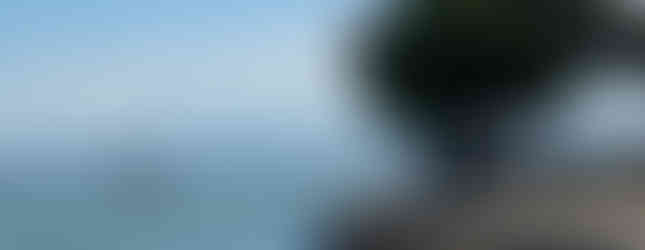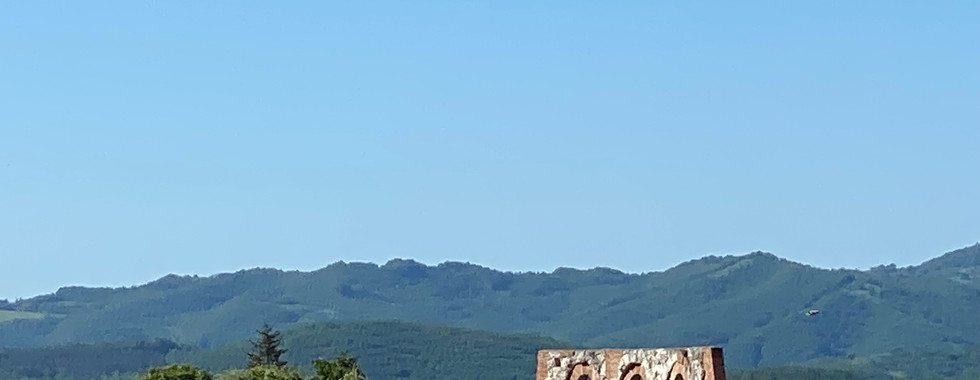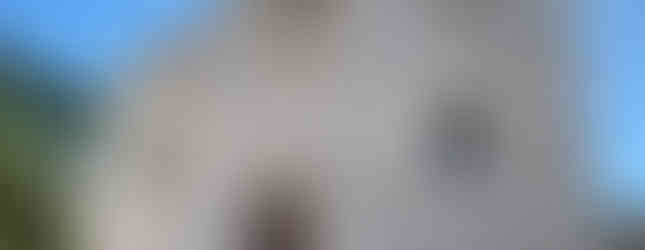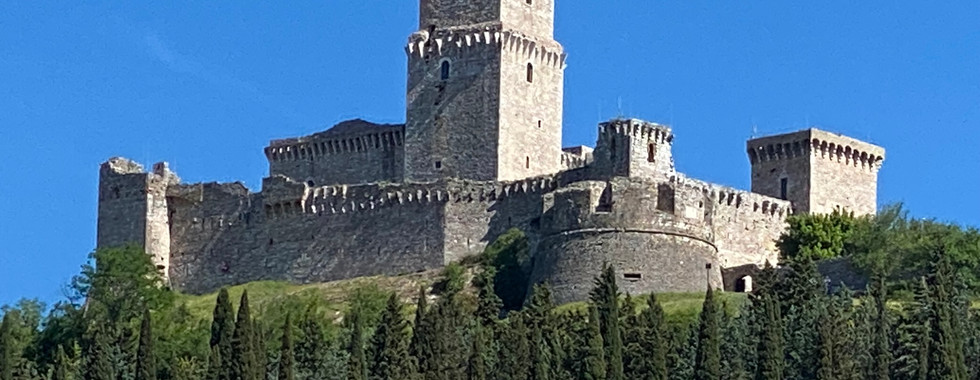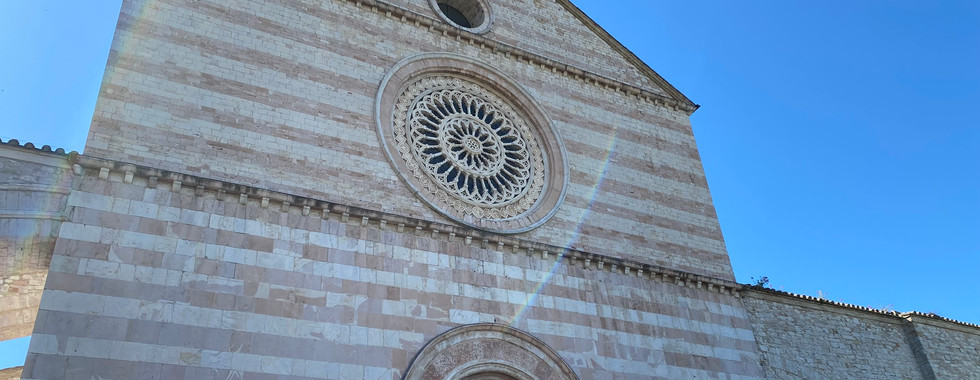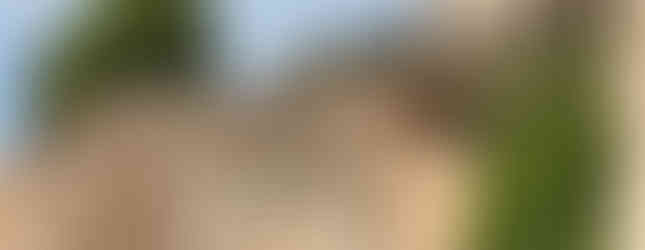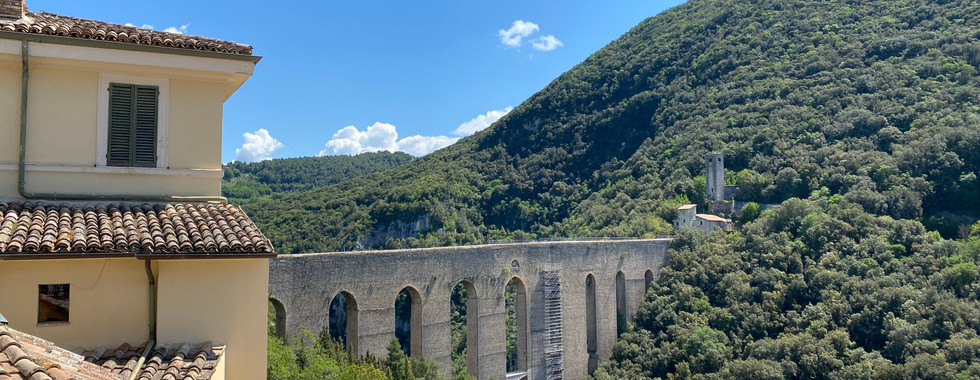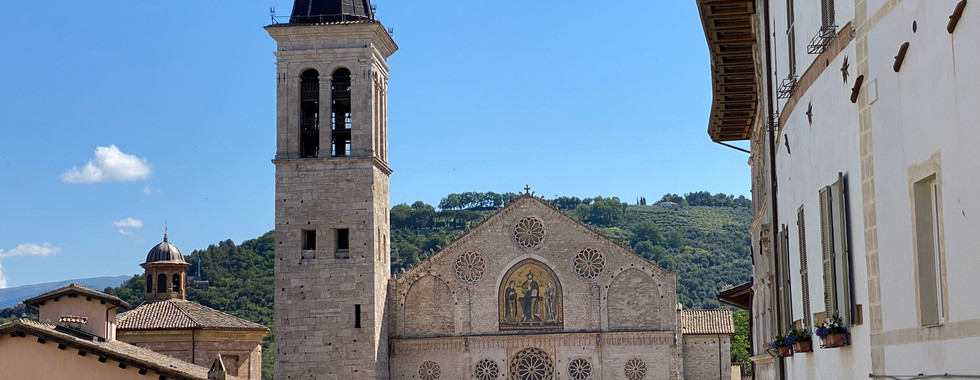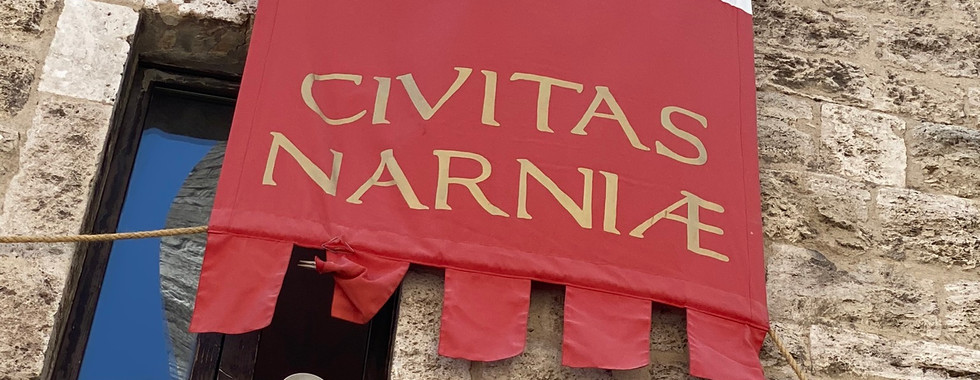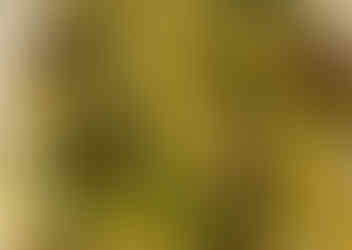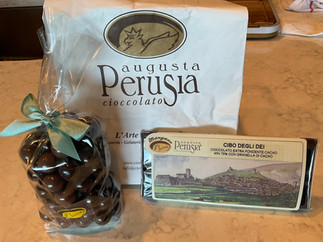
Thinking of a trip to Italy? Been there before and not sure where to explore next? Dreaming of the landscapes you've seen in magazines of Tuscany?
I have recently returned from a lovely week in the Tuscan and Umbrian countryside, and I can attest to this being a trip which provided exactly the visions I had in mind for this one-week journey. Now, if you have not yet been to Italy, I'm not sure I would recommend this trip before visiting Rome, Florence, and Venice, as those iconic cities really introduce you to Italy well. But, if city visits are not your thing, then absolutely make this trip a priority as it will fill your heart and soul with much beauty, food, and history. And, if you can arrange a trip in early-mid May (or mid-late September/ early October), I think you'll be very happy with the weather (and thinned-out crowds).
I took an escorted tour run by the well-regarded high-end tour company Tauck, which visited hill towns outside and between Florence and Rome (but not including those cities). For me, this tour made sense as it happened to go to places I hadn't been and there was an emphasis on food, wine, and ancient cultures, all of which appeal to me. As it happened, the weather gods smiled down on us, which made the trip even better (probably because I brought an umbrella and rain coat, lol)!
The specific itinerary was as follows, by day:
Arrive at hotel outside Florence (Villa La Massa) -- see Chianti section for more on this hotel
Visit Arezzo in morning and drive to Gubbio (via a gelato stop at Lake Trasimeno) in afternoon
Gubbio & truffles
Assisi in morning and drive to Perugia with lunch stop in a vineyard followed by a wine tasting en route
Explore Perugia (including chocolate tasting & visit to weaving studio)
Drive to and explore Spoleto, then visit Narni underground before ending up in Rome
Fly home from Rome
Obviously, there is no way I could write about a trip to Italy without including some food porn or discussion for you. The big take-away is that this part of Italy is home to possibly the most delicious olive oil I have ever tasted, and of course, there is also the wine, cheese, pasta, legumes, truffles, and chocolate for which this region is well known. Should you want to skip straight to the food discussion and pictures, click here. (No judgement.)
Wondering why I took an escorted tour rather than plan my own itinerary and travel independently? I mean, I DO love planning itineraries... When an escorted tour company I trust (there are several) has an itinerary which pretty much matches what I would do and where I would go on my own, stays in hotels I would consider, and they take care of the driving and many of the meals for less money than I could do it myself, I see little reason to go it alone. Plus, in small medieval towns, where two-way roads are one-lane wide, it's definitely better for my marriage and blood pressure to let someone else do the driving. (FYI, hiring a driver for a week is extremely expensive.) The maximum tour size for this particular tour was 24, and as it happened, it was an excellent assortment of travelers. No duds at all, which is, quite frankly a first (and I have taken a pretty decent number of tours, so that is saying a LOT). You'll need to do your own math to decide whether planning everything yourself (or with the help of a travel advisor) and managing the transportation on your own (either with a rented car or with a driver) outweigh the lack of flexibility and the possibility of needing to socialize (to some extent) with a person or people who might not be your cup of tea are worth it. Sometimes it is for me; other times, not.
A couple of travel tips based on this trip:
If you miss a flight connection and are told you have been re-booked on a flight many hours later, you should feel free to object and see if there is another possibility -- even on a different airline or through adding another stop to the route. You'd be surprised what can happen when you don't just accept the easiest alternative for the airline. Had I been ok with the automatically re-booked flight option I was given, I would have spent more than 12 hours at an airport and arrived 10 hours later than I was supposed to arrive. By routing us through another city (yes, that meant an extra leg of the journey) and on another airline, we arrived about 3-4 hours later than we would have if we had made the original connection.
If air conditioning is important to you, please know that just because a hotel HAS air conditioning (always check!), make sure that the system will be turned on when you are there. Mid-May, apparently, is earlier than some hotels will turn on the system, and had I known that, I would not have stayed there (or, in this case, taken the tour). Learn from my mistake.
If you are concerned about needing to socialize with folks on a tour who may not be your cup of tea, try to convince friends to join you so that you always have folks you enjoy around -- just in case. As it turned out, we liked all the folks in our group so having our dear friends with us was not "needed," but it was wonderful sharing the trip with them regardless.
CHIANTI
Chianti is a (wine) region in Tuscany which offers picturesque and stereotypical landscapes. It is not far from Florence, where we stayed at one of the best hotel properties I have ever seen (Villa La Massa), and which could not have been a better home base. My room was luxurious and both my room and the hotel had views to die for. In Chianti, we had a great cooking class at Fonte de Medici where we made tagliatelle pasta with pancetta, sage, and tomato sauce, a warm pecorino flan with a zucchini puree, and a dessert with chocolate chip whipped cream inside and sponge cake exterior with drizzled chocolate. (A coming post will have at least one of those recipes). While cooking, and then eating the fruits of our labor, we tasted three wines from the Antinori winery -- a white, a Chianti Classico, and a Chianti Classico Riserva (my fave).
The best take-aways?
11am is the perfect time to start drinking wine in Italy. Who knew? (Actually, someone in the group mentioned that she heard a similar thing in France -- maybe there's something to it??)
When making tomato sauce from canned tomatoes, add baking soda instead of sugar to make it less acidic.
If you don't want to babysit your sauce, add extra water before the reducing period and it will be fine!
AREZZO
Arezzo is an ancient hilltop walled city in Tuscany. It has beautiful piazzas and the town dates back to the days of the Etruscans (pre-Roman), in the 4th and 5th centuries, BC. There's much architecture still intact from the 11th up to the 19th centuries, which we saw on a walking tour of the city. Arezzo is home to many antique stores and has numerous famous artists who hail from there including Michelangelo (well, sort of as he's from near there), Giorgio Vasari (architect of the Uffizi in Florence), and Guido Monaco (aka Guido d'Arezzo), arguably the inventor of the modern musical staff notation. Art restoration also takes place in the town, and a visit to Ricera Restoration was fascinating -- the restorers have a staff upon which they lean their hand for stability (see picture above).
There also happens to be some amazing food in Arezzo, and we enjoyed a most memorable lunch at the Michelin noted restaurant Le Chiavi D'Oro (artichoke flan with white truffle and percorino fondutto, gnocchi, and perfecty cooked octopus over a yellow tomato sauce were standouts). While Arezzo's popularity is growing, it is not overly-touristed.
GUBBIO
Gubbio is a fairly small city located on a hillside in Umbria, and is the self-proclaimed most beautiful medieval town. (And I can't say I disagree). It is home to the oldest group of inhabitants in what is now Italy -- the Umbrians, who were there even before the Etruscans arrived. The city is beautiful, built into the hillside, and has many of its medieval buildings still intact (they were not bombed in the world wars nor impacted by nearby earthquakes). Gubbio is well-known for its truffles, and while we did not participate in the excursion, there was a truffle hunt which was apparently a lot of fun. The town is picture-perfect, the cuisine simple (but good), and there is much life in the city, especially at night. There is enough to explore that even though I only spent a day there, I would recommend two, at least. Oh, there is an ancient roman theater just outside the ancient town walls...
Gubbio is where Francis (pre-sainthood) came shortly after dedicating his life to God, and where he miraculously managed to tame a ferocious wolf that had been terrorizing the inhabitants for some time, and is why St. Francis is known as the saint for animals and humans.
The town has been dubbed the city of crazies in Italy because of an annual race with giant heavy (over 600 pounds) "candles" being run from the main square in town up to the Basilica of St. Ubaldo (the town's patron saint), on the top of the mountain (which is accessible by a standing sort of chair lift if you are not up for the steep switchback walk up or down). The views are lovely and you can grab a drink and a sandwich made with the traditional bread, crescia, up there.
Want to know what my favorite learning of the day was? A theater is a semi circle while an amphitheater is a full circle! Maybe you knew, but I had never realized that before. Knowledge is power.😊
ASSISI
Home of Saint Francis and the order of Franciscans, Assisi is a very well-known hill town in Umbria. Due to its religious importance, and the fact that it is a place for pilgrims to stop, the town is usually crowded with tourists. That said, it is a beautiful city even for those who are not there to pray. (To be clear, there are lots of churches and basilicas in which to pray, should that be your desire). Photography is not allowed in the primary basilicas, but they are spectacular, with artwork by Giotto and other renaissance masters. I happened to visit on a Sunday and was able to observe part of a mass, and it really was glorious. The town sits across the valley from Perugia, its rival city-state even today.
PERUGIA
Perugia is a town known best for its chocolate, its artisans, and its history. It is yet another beautiful hill town (Dominican) and faces its rival city, Assisi (Franciscan) across the valley. The town is steep enough that there are multiple elevators and escalators for folks to get around town. The two most important guilds were the banking and commerce, and you can visit the banking one which exudes wealth and has impressive inlay.
What I found most interesting about Perugia is the fact that the "modern" city is built on a fortress which was erected in the 16th century by Pope Paolo III, who destroyed the Etruscan city which was on that same site before, including the cathedral. (Can you say vindictive??) You can visit part of the basement of the papal palace under the current (modern) city, and in the tunnels you can see evidence of the Etruscan structures by noting the change in building materials. Fascinating.
We also visited a weaving company which produces traditional Perugian designs using the old style looms, which was well worth the time, as was a chocolate tasting later in the day. There really is a lot of chocolate to be found throughout the town, which is home to the original "Baci" made by Perugina (chocolate with a hazel nut on top).
Perugia also is home to at least two universities -- one specifically for foreigners, so if you feel like studying abroad...
SPOLETO
Yet another picture-perfect medieval hill town in Umbria, Spoleto has been inhabited since the bronze age and because of its strategic position at the top of a hill, it has enjoyed fame and wealth since before the Roman Empire. Of course there are many beautiful churches to visit, and the 12th/13th century Duomo (cathedral) S. Maria Assunta has some well-known renaissance frescoes relating to Mary's ascension.
There is an ancient Roman theater in town which is actually built in the Greek style (built into the hillside — safer for earthquakes, but therefore no decorative facade) which dates from the 1st century BC, which is part of an archeological museum. The 13th century Roman medieval aqueduct is still functioning, and is visible from the base of the Fortress (Rocca) atop the city (accessible by a series of escalators if you don't feel like walking up).
Today the city has an elegant feel with pretty shops and restaurants which, like the others in the area, serve black truffle and lots of red wine (mostly from Montefalco) and is best known for its annual (art & music) Festival of Two Worlds (end of June/beginning of July) which brings in many visitors. Oh, and in Spoleto, I was told that "any meal in Italy without wine is breakfast!" Food (er, drink) for thought...
NARNI
Last, but certainly not least, was a visit to the very small Umbrian hillside town of Narni. In Narni, we visited an underground archaeological site (Narni Underground) which was discovered by a group of friends spelunking in 1979. They unearthed an ancient Domenican church, as well as an adjacent torture chamber from the Inquisition (which had been recorded but kept secret in some Papal papers). The isolation chamber was said to provide three levels of torture: the basic torture of being isolated, plus its location was adjacent to the torture chamber, so prisoners could HEAR the torture in the next room, and lastly, the excrement and pee from other prisoners was poured into a pot in the corner from the room above. (Hard to say which of the three was the worst kind of torture, right?!)
Further digging (remember, so many Italian structures are built upon earlier ones) unearthed Byzantine mosaics under another nearby/ adjacent church (which now functions as a town hall of sorts). The town is well worth a visit as it is charming and not over-run with tourists (yet). And, as I am sure you are wondering, yes, this is from which CS Lewis got the name for his Chronicles of Narnia.
FOOD & DRINK
Onto a favorite topic, I present some pictures of standout dishes consumed on this journey (not all by me!). Please note that it was asparagus, artichoke, and zucchini season, and that Florence is known for its steak, so when we were in the area... (You'll see below).
I need to reiterate how amazing the olive oil from this region was, and if you like truffles, this is the region to visit. The souvenirs I brought home fell into only two categories: textiles (from the weavers in Perugia) and consumables: olive oil, vinegar, truffle honey (omg and who knew??), truffle spread, wine, and some chocolates. Because, of course!
A note about ordering gelato: We were informed that single scoops were not a thing, and that, in many cases, if the proprietor didn't approve of the combination of flavors ordered (if you chose to have more than one), they may not serve what you asked for. We chose well (dark chocolate & stracciatella (chocolate chip)), so had no issues.
Oh, one curious (interesting) but good-to-know thing... Bread is always brought to the table when you sit down in this region, but without olive oil (or butter). You can ask for oil (as we did at times), but apparently the bread is there primarily for sopping up the delicious sauces which will accompany your meal. There was no explanation given when asked why the bread didn't therefore come when the food was brought out.
OK, that's it, folks! Hope you have found this informational and even potentially aspirational.
Happy travels!!






























